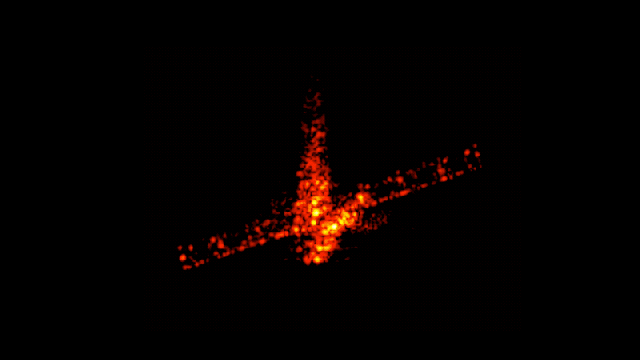In late July, the Aeolus Earth Explorer satellite plunged through Earth’s atmosphere to burn up as scraps. Its unprecedented controlled reentry was captured through a series of images that show the spacecraft during its tumbling, fiery demise.
The European Space Agency (ESA) released a new animation made from the last eight images taken of Aeolus, revealing the final moments of the satellites as it began to tumble its way through Earth’s atmosphere as a giant fireball.
The images were captured by the Tracking and Imaging Radar (TIRA), a space observation radar at Fraunhofer FHR in Germany. Using its 110-foot-wide (34-meter-wide) antenna , TIRA tracked Aeolus on July 28 at around 12:20 p.m. ET for about four minutes as it was making its way down, according to ESA.
The flight control team sent its last command to Aeolus at 11:34 a.m. ET, after which they could no longer communicate with the satellite. Aeolus had been orbiting Earth for the past five years, measuring the planet’s winds on a global scale. However, the satellite was running out of fuel and being pulled down by gravity and atmospheric drag. In an effort to curb the growing issue of space debris, ESA carried out a first-of-its-kind assisted reentry for its defunct satellite.

As part of its reentry, a series of complex maneuvers lowered the satellite’s orbit from approximately 199 miles (320 kilometers) to a mere 75 miles (120 km). At around 2:40 p.m. ET, Aeolus became a fireball falling through Earth’s atmosphere. ESA’s Space Debris Office tracked its final descent.
“Normally, once a mission goes into the nose of its rocket and the fairing closes around it, that’s the last time we expect to ever see it,” Tommaso Parrinello, Aeolus mission manager, said in the ESA statement. “With Aeolus, in a remarkable example of sustainable spaceflight and responsible operations, we stayed with the mission for as long as we could, guiding its return as much as it was possible to do, and these images are our final farewell to the mission we all miss, but whose legacy lives on.”
For more spaceflight in your life, follow us on Twitter and bookmark Gizmodo’s dedicated Spaceflight page.
